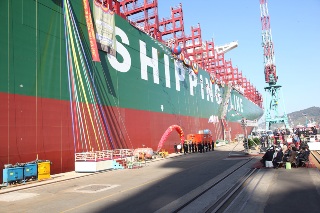 The title of “world’s biggest” has been wrestled from Maersk’s giant 18,000-TEU series with the coming of the 19,000-TEU “CSCL Globe” of China Shipping Container Lines (CSCL), which was recently christened in South Korea in preparation for its deployment on the Asia-Europe trade.
The title of “world’s biggest” has been wrestled from Maersk’s giant 18,000-TEU series with the coming of the 19,000-TEU “CSCL Globe” of China Shipping Container Lines (CSCL), which was recently christened in South Korea in preparation for its deployment on the Asia-Europe trade.
CSCL Globe, named in ceremonies at the Hyundai Heavy Industries shipyard in Ulsan, South Korea, is the first of a series of five 19,100-TEU container ships CSCL ordered in 2013. All of the vessels in the series will be constructed to DNV GL class.
CSCL Globe measures 400 meters in length, 58.6 meters in width and 30.5 meters in depth and is “as large as four soccer fields,” according to a DNV GL statement.
The carrier will be deployed on the Asia-Europe trade loop after being handed over to the owner this month.
The ship and its sisters have energy-saving features that allow them to burn 20% less fuel per TEU in comparison to a 10,000-TEU container ship. They also boast more efficient use of cargo capacity with more flexibility, and more laden containers on board on specific routes without compromising safety.
Trend toward gigantism
Meanwhile, the Baltic and International Maritime Council (BIMCO) noted that the takeover of sea lanes by the ultra-large container vessels (ULCVs) like the CSCL Globe is inevitable. This “trend to gigantism and its seemingly unstoppable momentum” will have an impact on ports big and small because of the practice of cascading, it noted.
“All around the world, in ports where far smaller ships serve their trades, their managers will be looking with a certain apprehension at the delivery of these giant vessels,” it added.
“If a port has just finished a dredging scheme or reconstructed its container terminal to take 4,000-TEU ships, there is no way it can be sitting on its laurels, because sooner or later the pressure will be on it to provide water depths and berths to accommodate 6,000-TEU ships.”
And just as ports and terminals are racking their brains about how they will handle the ultra-large container ships, “small harbors and little upriver ports just about capable of taking a 1,500-DWT short sea vessel are worrying about their future with the trend being towards ships 1,000 DWT larger,” said BIMCO.
It pointed out that it is much easier for a ship operator to scale up than it is for facilities to do the same because this entails massive investment in shore infrastructure such as deeper water access and new designs.
BIMCO continued that a similar trend for 500,000-DWT ULCVs in the 1970s never really caught on, partly because of their inflexibility, “but also because the recipients of their cargoes did not wish to expand their tank farms to cope with the huge parcels delivered by the single ships.”
While the economies provided by the move to bigger ships today still remain convincing, BIMCO said it cannot predict where the race to own mega ships will lead. “Whether the curve will start to flatten out, or whether the price and practicality of far bigger units will eventually restrict their numbers, remains to be seen.”




